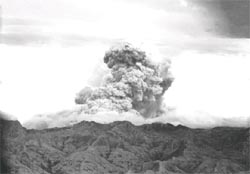Lava tracking
 two French geophysicists have claimed that the combined force of the wobble of the Earth's spinning core and the gravitational pull of the Sun and the Moon may have triggered massive volcanic eruptions in the past. They have put forward a model that correlates these activities leading to eruption of hot rocks from the interiors of the third rock from the Sun.
two French geophysicists have claimed that the combined force of the wobble of the Earth's spinning core and the gravitational pull of the Sun and the Moon may have triggered massive volcanic eruptions in the past. They have put forward a model that correlates these activities leading to eruption of hot rocks from the interiors of the third rock from the Sun.
The Earth's inner core is fluid in nature. This fluid core rotates at a slightly different rate than the mantle surrounding it. They also wobble with slightly different periods while they spin. Lunar and solar tides, which take place due to the gravitational pull of the Moon and the Sun respectively, enhance the wobble of the core when their periods coincides with its period. This leads to a resonance that increases the relative motion between the core and the mantle. This relative motion further leads to the building up of friction between the core and mantle. But these factors are changing over time because of the gradual slowing down of the Earth's rotation and the Moon gradually orbiting further from us.
According to the calculations of Marianne Greff-Lefftz of the Institute of Global Physics in Paris and Hilaire Legros of the University of Strasbourg, these effects would have peaked thrice in the past, once each around 3 billion years, 1.8 billion years and 300 million years ago. Greff-Lefftz adds that the resonant episodes would have lasted about a million years and increased the friction at the base of mantle 10,000 times ( Science , Vol 286, p1707).
She suggests that this frictional heating would have led to massive eruptions of hot rocks from the deep mantle towards the surface of the Earth, thus explaining the massive volcanic eruptions. Interestingly, the first two resonances coincide with event of formation of the largest volumes of rocks on the planet's crust. The most recent one coincides with largest known eruption of flood basalts in Siberia about 250 million years ago.
Mi Feng, a geophysicist at the Massachusetts Institute of Technology in the us , says that the idea is quite provocative and stimulating but the Greff-Lefftz model ignores the larger forces that the Earth's gravity, pressure and magnetism generate at the core.
